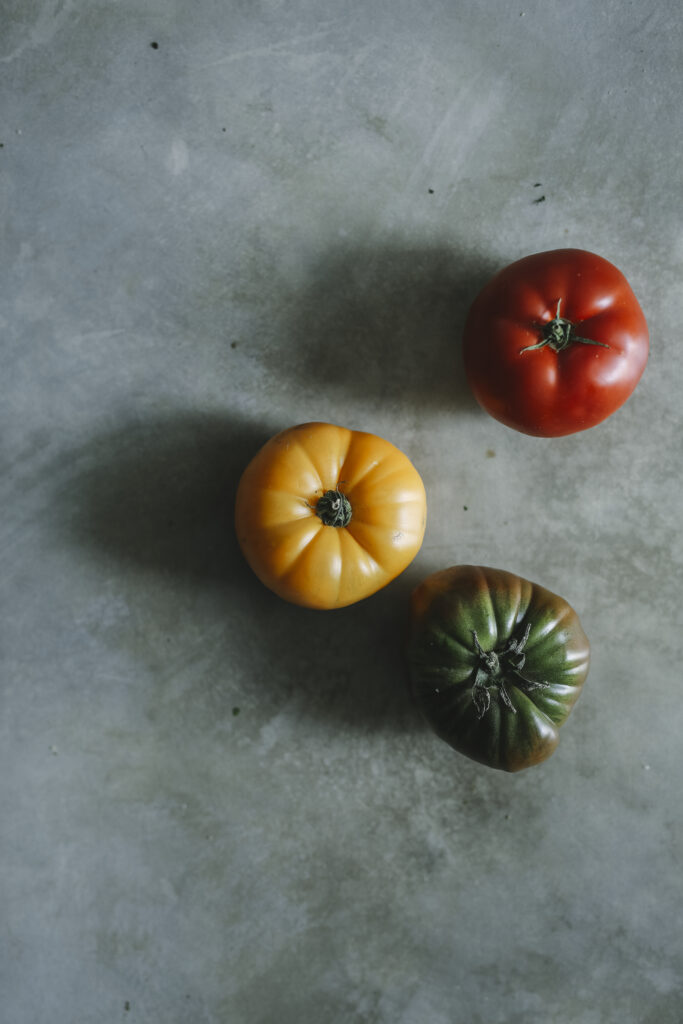By now, we’re all familiar with heirloom tomatoes. We’ve encountered them at farmers markets, grocery stores, on restaurant menus, and even at that recent dinner party. We know they’re often oddly shaped, vibrant, and visually striking, making them a feast for the eyes.
But is that the case? And if so, why? What exactly are heirloom tomatoes? These are the questions that come to mind as we eagerly anticipate the transition from July to August, when tomato season hits its peak and heirloom tomatoes are at their best.
Despite the name, heirloom tomatoes are not the kind of ‘heirlooms’ you’d find in an antique store or your grandmother’s attic. These tomatoes are not dusty relics handed down through generations like old yearbooks or silver lockets. It’s the seeds that carry the unique legacy of heirloom tomatoes, making them a fascinating subject for any gardener or farmer.
What defines an heirloom tomato is its seeds. These seeds, the heart of the heirloom legacy, are passed down from season to season, saved by dedicated farmers from the plants that produce the best fruit. This selection process, driven by the passion and commitment of these farmers, allows for the cultivation of desirable traits like juiciness, size, shape, and color. Heirloom tomatoes are also typically open-pollinated, meaning they are pollinated naturally by birds, insects, wind, or human hands—no genetic modification involved.
Heirloom tomatoes stand out for their potential greatness because their DNA has yet to be manipulated like that of many mass-market tomatoes. Most tomatoes in grocery stores are bred to look perfect—plump, red, round, and easy to store. These tomatoes are designed for consistency, not flavor, which benefits sellers but not buyers. We’re talking about those watery, mealy, flavorless tomatoes often found on fast-food burgers—hard pass.
We love heirloom tomatoes for their unique qualities. Like apple varieties, their colors, textures, sizes, and flavors vary widely. A black Krim tomato will look different from an Azoychka, making tomato salads more interesting. A classic caprese salad made with a mix of heirlooms turns into a vibrant display of color and flavor.

However, just because a tomato is labeled “heirloom” doesn’t guarantee it’s delicious. Many huge farms use the term “heirloom” to market genetically modified seeds or tomatoes grown with poor practices, capitalizing on the heirloom trend while selling inferior products that may have traveled thousands of miles. The term “heirloom” is unregulated, like “natural,” so it’s a buyer beware situation—being called an “heirloom” doesn’t automatically mean the tomatoes were grown locally, organically, or with high-quality practices. Even the best local farms sometimes produce lackluster tomatoes, regardless of their seed stock, farming methods, or intentions. The only way to ensure you get a tasty, high-quality heirloom tomato is to buy from a trusted source.
That’s why we prefer buying our tomatoes at farmers’ markets. We can ask about the variety and growing methods and often taste a sample to ensure we get what we want. And we want a bright, colorful, juicy, flavorful tomato with a bit of history—a true heirloom.
Summary
Heirloom tomatoes are celebrated for their unique shapes, vibrant colors, and rich flavors, defined by seeds passed down through generations. Unlike mass-market tomatoes bred for consistency, heirlooms are naturally pollinated, ensuring diverse and superior taste. However, the “heirloom” label is unregulated, meaning not all are high-quality or locally grown. For the best heirloom tomatoes, buy from trusted sources like farmers’ markets, where you can inquire about growing practices and sample the produce.




